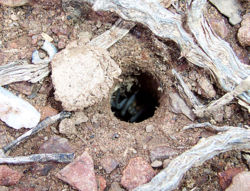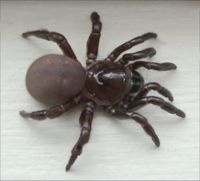Trapdoor spider
2007 Schools Wikipedia Selection. Related subjects: Insects, Reptiles and Fish
| iTrapdoor spiders | ||||||||||||||
|---|---|---|---|---|---|---|---|---|---|---|---|---|---|---|
 Trapdoor spider in burrow
|
||||||||||||||
| Scientific classification | ||||||||||||||
|
||||||||||||||
| Diversity | ||||||||||||||
| 9 genera, 120 species | ||||||||||||||
 |
||||||||||||||
|
|
||||||||||||||
|
Bothriocyrtum |
Trapdoor spiders (superfamily Ctenizoidea, family Ctenizidae) are medium-sized mygalomorph spiders that construct burrows with a cork-like trapdoor made of soil, vegetation and silk. The trapdoor is difficult to see when it is closed because the plant and soil materials effectively camouflage it. The trapdoor is hinged on one side with silk. The spiders, which are usually nocturnal, typically wait for prey while holding onto the underside of the door with the claws on their tarsi. Prey is captured when insects or other arthropods venture too close to the half-open trapdoor at night. The spider detects the prey by vibrations and when it comes close enough, the spider pops out of its burrow and captures it. Male trapdoor spiders can overcome the females' aggressive reactions to their approach, but it is not known how. Females never travel far from their burrows. Eggs are laid in sacs in the female's burrow. Enemies of the trapdoor spider include certain pompilid (spider) wasps, which seek out the burrows and manage to gain entrance. They sting the owner and lay their eggs (usually one per spider) on its body.
The taxonomy of trapdoor spiders is currently not well understood in the United States and many species of the common genus Ummidia remain undescribed. Ummidia is distributed across the southern United States. Bothriocyrtum californicum is the common trapdoor spider of the Pacific Coast. The strange genus Cyclocosmia includes four species, one in Florida, one in Georgia, one in Mexico and one in China. The discontinuous distribution is indicative of a primitive genus that was affected by continental drift. The spiders of this genus are unusual in having a mask-like hardened plate on the opisthosoma, which seems to act as a second door to exclude predators, like the spider wasps. There is a narrow part of the burrow of these spiders where the abdominal shield just barely fits. Cyclocosmia torreya builds burrows in moss banks along the Apalachicola River in Florida. Other genera of trapdoor spiders are found in other areas of the world. They actually may be more common than we may think because of their cryptic habits. They do tend to be localized in distribution and as such may be subject to extinction because of local habitat destruction. Malaysia has 8 species of Liphistius Liphistiidae spider, some of which are endemic to certain places such as a cave.
Genera
- Bothriocyrtum Simon, 1891 (USA, Mexico, Taiwan)
- Conothele Thorell, 1878 (New Zealand, Australian region)
- Cteniza Latreille, 1829 (Europe, Central Asia)
- Cyclocosmia Ausserer, 1871 (USA to Guatemala, Thailand, China)
- Cyrtocarenum Ausserer, 1871 (Greece, Turkey)
- Hebestatis Simon, 1903 (Costa Rica, USA)
- Latouchia Pocock, 1901 (Asia)
- Stasimopus Simon, 1892 (South Africa)
- Ummidia Thorell, 1875 (America, Mediterranean, Japan, Taiwan)
